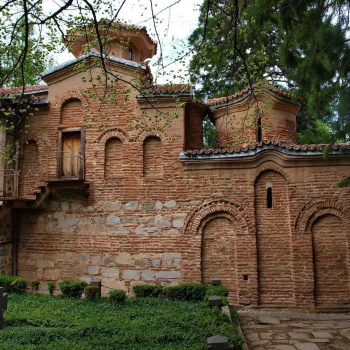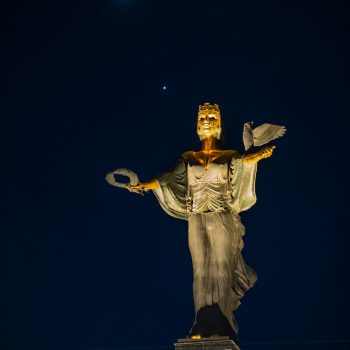About Sofia, Bulgaria

“In the heart of the Balkans, Sofia stands as a testament to resilience, a city that has weathered
the storms of history and emerged with its spirit unbroken.”
“The Balkan Trilogy” by Olivia Manning


Nestled in the embrace of rolling mountains, Sofia, Bulgaria, is a city that whispers tales of centuries gone by. Its name, Sofia, means wisdom, and indeed, this city is a repository of ancient knowledge and timeless grace. Sofia has a rich and diverse history that spans thousands of years. It has been inhabited by Thracians, Romans, Byzantines, Ottomans, and Bulgarians. The city’s history is reflected in its architecture, culture and traditions.
Sofia’s story begins over 7,000 years ago when it was a Thracian settlement known as Serdica. The Thracians were a fascinating civilization, known for their fierce warrior culture and intricate gold craftsmanship.They chose this location for its strategic position, nestled amidst mountains and fertile plains.
The story of Roman Serdica begins in the 1st century AD when the Roman Empire conquered the Thracian settlement of Serdica. The Romans recognized its strategic importance and transformed it into a thriving urban center. Under Roman rule, Serdica witnessed a remarkable architectural transformation. Grand structures like thermal baths, forums, and an amphitheater graced the cityscape. Some of these ruins are still visible today. The Romans brought with them not only architectural splendor but also their culture, governance, and trade. Serdica thrived as a key trading hub, connecting the East and West. The remnants of Roman Serdica are still present in Sofia, where archaeological excavations have uncovered a wealth of artifacts, including intricate mosaics and statues. The city’s streets, which follow the original Roman grid plan, are a testament to its enduring legacy.
Sofia’s connection with Byzantium, the Eastern Roman Empire, dates back to the 4th century AD. As a thriving Roman city, it fell under Byzantine rule, marking the beginning of a lasting influence. The Byzantine Empire played a pivotal role in the spread of Christianity, and Sofia was no exception. Iconic churches and religious sites were erected, such as St. Sofia Church and the Church of St. George, showcasing Byzantine architectural and artistic traditions. Byzantine architecture left an indelible mark on Sofia. The use of domes, mosaics, and intricate frescoes is evident in several of the city’s churches and religious buildings. Byzantium’s influence extended to trade and commerce. Sofia thrived as a significant trade hub, connecting Europe and Asia, thanks in part to Byzantine economic policies. Sofia’s strategic location in the Balkans made it an important outpost for Byzantine rulers, who recognized its value as a cultural and political center.
The Ottomans first conquered Sofia in 1382, during the reign of Sultan Murad I. This marked the beginning of nearly five centuries of Ottoman rule in the city. Sofia became an important administrative and economic center in the region. It was part of the Ottoman province of Rumelia and served as the capital of the Eyalet of Sofia. The Ottomans encouraged the conversion of the local population to Islam. As a result, many mosques and other Islamic structures were built in the city. Ottoman architecture, such as domed mosques and minarets, became prevalent in Sofia.The Ottomans made significant urban developments in Sofia, including the construction of public baths, bridges, and bazaars. The city’s layout and infrastructure were transformed during this period. The Ottoman influence extended to Sofia’s culinary traditions. Delicacies like kebabs, baklava, and traditional Turkish coffee became part of the city’s culinary landscape.
The 19th century brought the dawn of a new era. The Liberation of Sofia in 1878 was a beacon of hope for a nation yearning for freedom. The Russo-Turkish War led to Sofia’s emancipation from Ottoman rule and set the stage for a new, independent Bulgaria. Sofia became the capital of the newly formed state, a symbol of resilience and aspiration.
Sofia evolved into a vibrant and cosmopolitan city in the 20th century. It bore witness to the tumultuous events of two world wars, as well as the profound social and political transformations of the Cold War era. Today, the city stands as a testament to the resilience of its people and their ability to adapt to change while preserving their cultural identity.
ART AND CULTURE
Sofia is not only a melting pot of history and modernity but also a vibrant hub of art and culture. From centuries-old traditions to contemporary expressions, the city thrives on the creative energy of its people. Here’s a glimpse into Sofia’s thriving art and cultural scene:
Sofia is home to a treasure trove of museums and galleries that offer glimpses into the nation’s artistic heritage. The National Gallery for Foreign Art showcases a captivating collection of European and non-European art, while the Sofia City Art Gallery celebrates local contemporary artists. The National Museum of History, with its extensive collections, unveils the intricate threads of Bulgaria’s past.
Unearth the layers of history in Sofia through its historical landmarks. The Alexander Nevsky Cathedral, a symbol of national pride, stands as an architectural masterpiece and an ode to Bulgarian Orthodoxy. Boyana Church, a UNESCO World Heritage Site, invites you to explore medieval Bulgarian art. The Serdica Archaeological Complex offers insights into Sofia’s Roman past, while the Ivan Vazov National Theater, a masterpiece of architecture, is the heart of Bulgaria’s theatrical scene.
Sofia’s music scene is a symphony of diversity. The Sofia Opera and Ballet offers world-class performances, while the Sofia Philharmonic Orchestra enchants audiences with classical music. Indie concerts, underground clubs, and music festivals showcase the city’s vibrant and eclectic soundscape.
Bulgarian folklore traditions are deeply ingrained in Sofia’s culture. Experience the captivating world of folk music and dance through performances at the National Palace of Culture and local events throughout the city.
LANDMARKS AND ATTRACTIONS








TRAVEL TIPS
-
Currency
Bulgaria uses the Bulgarian Lev (BGN) as its currency. It's a good idea to exchange some money or use ATMs to get local currency when you arrive.
-
Language
The official language is Bulgarian (Cyrillic Alphabet).
-
Public transport
The public transport in Sofia is: Ground Transport – buses, trams (tramways), and trolleybuses and Underground – Metro. There are four metro lines in Sofia – M1; M2, M3 and M4. You can see the numbers of the lines on the front of the train. Sofia Metro connects Sofia Airport Terminal 2 with the center of the city – Serdika Metro Station. The trip takes about 20 minutes. Passengers can change metro lines at Serdika Metro Station and travel to Sofia Central Bus Station and Sofia Central Railway Station. Sofia Metro connects Sofia Airport Terminal 2 with Sofia South Bus Station, as well. The metrotrains from and to Sofia Airport run from 5:30 to 24:00 on weekdays and holidays.
-
Contactless payment possible in all public means of transport
Passengers can pay a single-trip ticket (1.60BGN/0.82EUR) by simply tapping their contactless credit or debit card (or a digital card uploaded to their NFC mobile wallet) on an on-board/metro gate reader. A daily cap limit for payment with credit or debit card – passengers can make as many journeys as they like over the day and all fares will add up to an amount of 4 BGN (approx. 2 EUR).
MORE INFORMATION
- For more infromation about Sofia, Bulgaria, please visit:
- For more infromation about the public transport, please visit:
